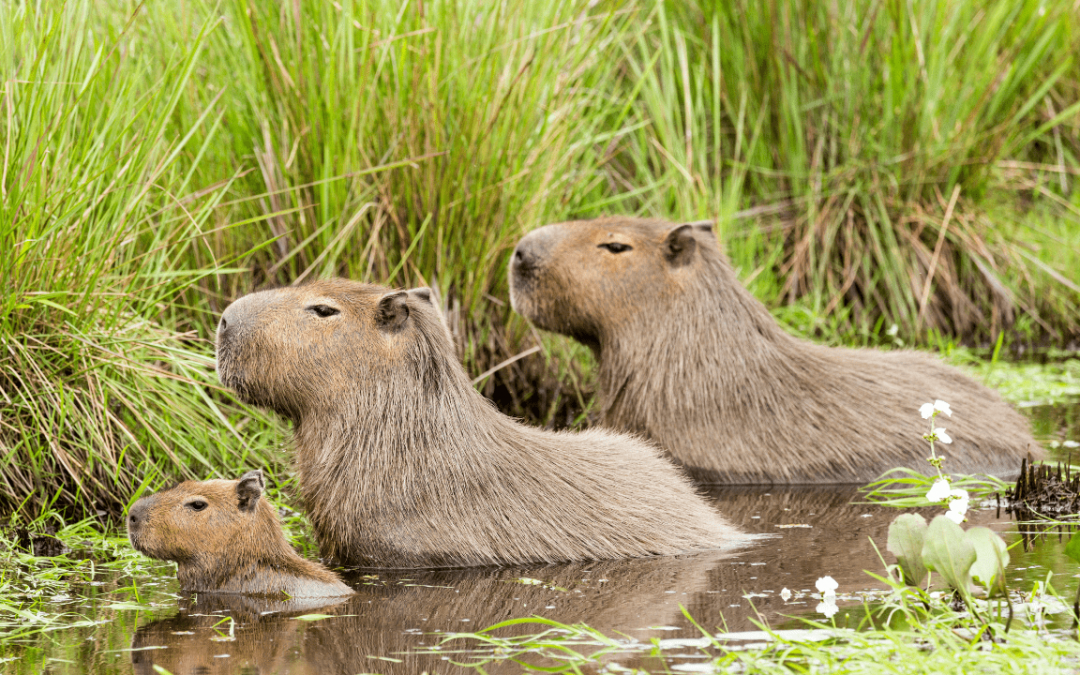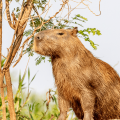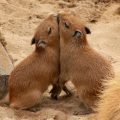Table of Contents
Capybaras are the big, very endearing, social, and affectionate exotic creatures that are called “giant guinea pigs”. They look like a beaver without a tail, a hairy pig, minus its pig-like snouts, a squirrel that is gigantic; a mouse that grew a thousand times, and a rabbit without the bunny ears. But, despite the similarities going on around the said animals above; they are very unique, from their physical features down to behaviors and their lifestyle. Their uniqueness made them popular and loved by many, and if you are a complete beginner about knowing capybaras? I’ll get you to know everything there is to know about them.
Physical Features
Capybaras have the title of the world’s largest rodents. They look very much alike with their close relative, guinea pigs only so much larger. These creatures have a head that is large and broad, with short and rounded ears; and little eyes that are located on the top of their heads, a snout that is wide; with a large upper lip and big nostrils; and neck and legs that are relatively short.
Capybara has four toes for their front legs and have three for their back legs, all that have short yet very sturdy claws. The feet are webbed to some extent, which allows them to swim greatly. Their front legs are shorter compared to their hind legs.
These animals bodies are concealed with short and coarse fur that is reddish-brown to grey for their upper body; with tints of light yellow to brown for their lower body. Their small, almost non -existent tales hold no function, and female capybaras are usually larger in physical attributes than their male counterparts.
Behaviors
Capybaras are known for their friendliness both within their own creatures and with humans. In the wild, they live in the form of communities that consist of up to 100 of their own species. They have a friendly, calm demeanor unless they saw you; or another animal as someone that is harmful, that is likely to bring danger.
They share their habitats with many other animals, explaining their very chill and relaxed composure because the other animals are very relaxed and safe to them as well; they easily get along altogether. Do you want to know what’s really fascinating? These highly sociable creatures can get along with their very own predators! Some spotted them hanging with very big crocodiles.
Birds, ducks, turtles, monkeys, these four animals seem to be their companions most of the time. Capybaras are warm-blooded, and these animals love to hang out on the top of their body; taking advantage of the warmth it gives, and capybaras? Love and do not get intimidated by it.
Curious as to how they behave in captivity? With dogs being the man’s best friend, so can capybaras! They appeal to be great exotic animals because they are affectionate towards their human companion. They are very smart and highly trainable. Of course, as to raising them yourselves, their habitat should mimic the wild; and they should have at least one of their own companion, and more importantly, the state or country where you are residing permits petting them, and encourages responsible pet ownership.
Lifestyle
Capybaras lead a semi-aquatic lifestyle, meaning they are very fond of water bodies as they are a great swimmer; and spend most of the time doing it. Due to their dry skin, they generally need water to be hydrated and remain healthy.
They use water as well to hide in times of danger; they can stay underwater for as long as five minutes at a time to hide from their predators. Their eyes, ears, and nostrils that reside on the top of their head allow them to effectively scan their environment while leaving their bodies safe underwater.
Crepuscular
As they are crepuscular animals, they are most active at dawn. When they are feeling uneasy, or threatened, they at times switch to being nocturnal, which they choose to sleep during the day; and be active at night to feast, since dark covers and gives them protection and safety from their predators.
They are herbivores, meaning they like to feast off of grass and water-based plants; they also like to eat vegetables and grains, when they have access to it. Like any other species of rodent, their teeth grow continuously throughout their life, and they deal with it by gnawing; and chewing their food in back and forth motion to grind them down.
They eat their own feces, in the morning when it is most likely to be rich in protein; this is because the plants and grasses they eat are hard to digest, so eating their own feces aids to it being much easily digestible.
They are very chatty in the wild, making them the life of the party because they like to communicate by whistling, clicking; and purring, they can bark at times as well, like a dog.
As for their lifestyle in captivity, they are needed to be in pairs, with a large enclosure; an accessible water cage for swimming, and a large amount of grass to feast. They need access to daylight, as they love warmth; and overall just a peaceful quiet safe sanctuary with a human companion that is serious about raising and caring for them. In return, they will be a great exotic pet that is loyal, caring, and affectionate.
Keep In Mind
Capybaras are indeed a unique gift of our nature, knowing they exist and all the information relating to their way of life is very endearing to hear! They are without a doubt, a gift to existing for both animals and humans, and getting to observe their cuteness in the wild, moreover raising them in captivity, will be a delightful experience we humans can get.






 Author and long-time animal lover. Sharing knowledge on pet care through experience and the written word.
Author and long-time animal lover. Sharing knowledge on pet care through experience and the written word.